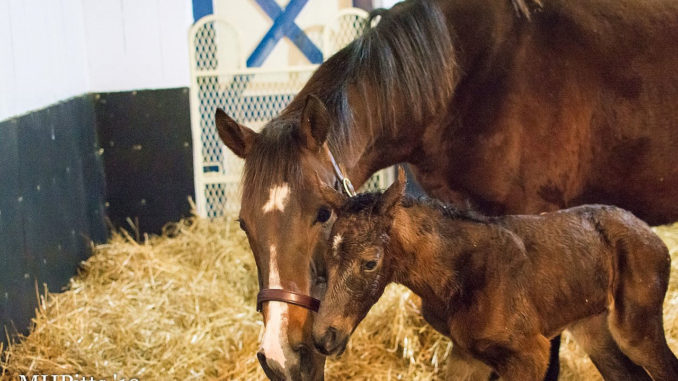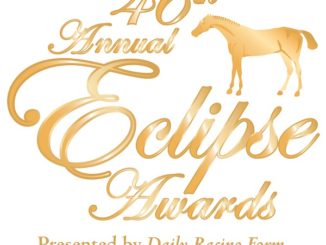
The birth of a filly to twice-beaten multiple champion Songbird shortly after midnight was arguably the biggest social media story in the racing world on a relatively quiet Monday this week. Not only is the Arrogate youngster the first foal produced by Songbird, but also the result of a rare mating between three-year-old champions from the same crop.
[See REILLY: “Songbird to begin broodmare career by visiting fellow newbie Arrogate”]
There are numerous examples of former champion three-year-old colts and former champion three-year-old fillies being bred and producing offspring, sometimes with highly notable results. But the matchmaking of a three-year-old champion colt with a filly of the same age has been very rare for any number of possible reasons. Among these are:
*Premature death of one or both champions.
*Geldings or sub-fertile colts earning championship honors.
*Tendency of breeders to send prized broodmares to established stallions rather than unproven ones soon after retirement or later.
*Champion colts not developing into commercially viable or attractive stallions.
According to Brisnet.com pedigree reports, the last offspring produced from a champion three-year-old colt and filly from the same crop was Slewvescent, a colt from the foal crop of 1988 whose parents were 1977 champions Seattle Slew and Our Mims.
Despite winning only once in seven starts with earnings of $15,600, Slewvescent had some success as a stallion. His most notable offspring included multiple Grade 1-winning turf filly Tout Charmant, 2001 Santa Margarita H. (G1) and Milady H. (G1) winner Lazy Slusan, and 2002 San Juan Capistrano H. (G1) victor Ringaskiddy. Slewvescent was also the broodmare sire of Grade 1-winning filly Last Full Measure and Grade 2-winning vixen Dancing House.
Buckpasser and Lady Pitt, the champions of 1966, produced three live offspring together. The fillies Queen Pot, foaled in 1969, and Bank of England, foaled in 1970, each won three small races. Queen Pot later produced King of Clubs, a Group 1 winner in Italy, while Bank of England reared Peter Pan (G3) winner Comptroller.
Lend Lease, a foal of 1973, was the only colt produced by a Buckpasser–Lady Pitt mating. Unplaced in three starts, he later sired six stakes winners in Canada and was the broodmare sire of Canadian champion and Vosburgh (G1) winner Victor Cooley.
The most successful offspring of champion three-year-olds from the same crop was the filly Batteur, a foal of 1960 whose parents were 1957 champions Bold Ruler and Bayou. In the mid-1960s, Batteur won two editions of the New York H. as well as the Santa Margarita, Santa Maria H., Santa Barbara H., and Santa Monica H. at Santa Anita. Batteur later reared Illinois Derby (G3) winner Flag Officer.
Bayou later produced the Bold Ruler fillies Bayonne, Bayou Blue, and Slew. None rose above being minor winners, though Slew produced Grade 1 winner Slew’s Exceller and Bayou Blue reared Louisiana Derby (G3) winner Country Light.
That sums up the history of families created by champion three-year-old colts and fillies from the same crop, but excitingly there might be a lot more to be written about over the next several years. Not only do we have the Arrogate–Songbird filly to look forward to, but 2015 champion filly Stellar Wind was reportedly going to be bred to American Pharoah after her purchase by Coolmore at the 2017 Keeneland November sale. It’s also been reported that Curlin and Rags to Riches, the stars of 2007 involved in a memorable Belmont S. (G1) duel won by the filly, are expecting a foal together this year.
If the name of the game is to breed the best to the best and hope for the best, this trend is not only encouraging but hopefully will produce results worth repeating again and again.




Loved your article….lot’s of work you put in and I appreciate that. Thank you! How do you track these new babies and find out there names so we can put them in our stable ‘watches’?